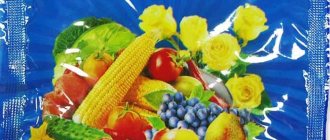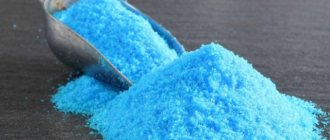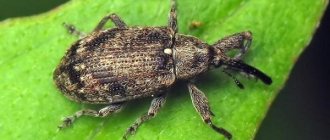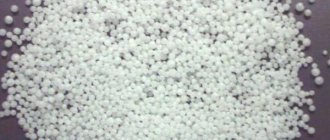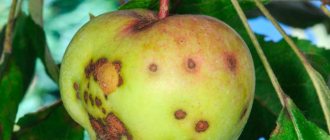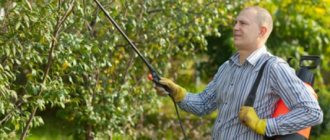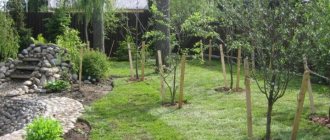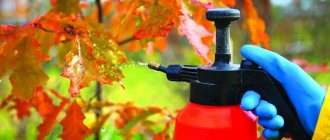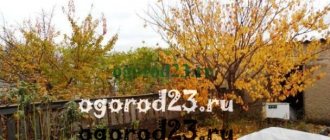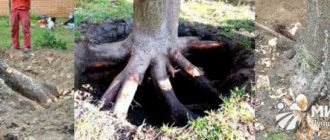Spraying garden trees in early spring contributes to the formation of a rich harvest in the coming season. Already at the end of March, the spread of spores of fungal diseases begins. And in April, pests also join them. Therefore, one of the most important tasks is to eliminate the danger in its “infancy”. The choice of funds is huge. But most gardeners and summer residents prefer copper sulfate and urea in early spring. These funds can be used both separately and together.
What does urea treatment provide?
Urea has found application in gardening as an organic fertilizer with mineral components.
The action of this concentrate is fast, and it retains its properties for a long time. Its weathering also occurs quickly. Urea needs to be treated not only with foliage and tree trunks, but also with the soil. For the same reason, it is added to greenhouse and greenhouse soil. When used correctly, the substance stimulates the growth and development of plants, feeding them with the nitrogen necessary for their full life. Treating trees with urea in the fall is safe. In autumn, the foliage will not burn if the concentration of the substance is slightly higher than normal. Trees and plants absorb nitrogen better after harvesting: during the summer season, all crops lose a lot of strength. They need useful substances that will support them during the transition to a state of suspended animation.
Urea inhibits vegetation processes and prevents early flowering in spring. There are varieties of plums, apricots and peaches that ripen early. For them, autumn treatment is necessary so that they do not bloom during the period of dangerous spring frosts.
After treatment with urea, harmful insects and fungal spores die. If there are old stumps on the site, urea will help get rid of them. Under its influence, stumps decompose and rot faster.
Attention!
When using urea, lime, chalk and superphosphates should not be added to the soil.
A mixture of urea and copper sulfate
What will this combination of drugs give to a gardener?
- By complementing each other, they enhance their antiseptic properties.
- They slow down the growing season a little, protecting flowering from late spring frosts (the buds will wake up 1.5 weeks later than untreated ones, but the trees will be stronger and stronger than their fellows).
- Last year's treated foliage will rot faster, and along with this, spores of pathogenic fungi and pest larvae will die.
- Massive invasion of aphids, scab phenomena, and late blight during epiphytotic years (spread of the disease over large areas) are perfectly exterminated by shock doses of this mixture.
Why treat your garden with this solution?
Health treatment of the garden in early spring is a prerequisite in order to obtain a top-quality harvest in the fall. Spraying helps to successfully combat insect pests, prevents many diseases and serves as fertilizer for fruit trees throughout the summer.
Two trustworthy means - urea and copper sulfate - eliminate the danger in their infancy. Copper sulfate (also known as vitriol or copper sulfur salt) is good at destroying mold fungi and spores, and has a beneficial effect on the process of photosynthesis in plants. Due to the high nitrogen content in urea (urea), crops respond with good vegetation, and the yield increases accordingly.
The preparations are diluted in water and the prepared solution is sprayed over the entire surface of the tree, as well as the ground underneath. Since the composition is highly concentrated, it is used before the buds begin to open.
Description of drugs and their effect on plants
Copper sulfate and urea have different effects on plants. It depends on their chemical composition.
Copper sulfate is copper sulfate, each molecule of which adds to itself five molecules of water. In gardening, it is used in the form of an aqueous solution as an antiseptic and fungicide - a substance that is used to combat fungal diseases of plants. This drug is contact, that is, it does not penetrate the tissue, but acts only on the surface.
Copper sulfate belongs to the class of low-hazard substances, but when working with it you must follow safety precautions: wear a respirator, protective clothing and goggles.
Urea (urea) is a chemical compound containing 46% nitrogen and is used as a nitrogen fertilizer. Soil bacteria decompose it to ammonia and nitrates. In this form it is absorbed by plants. Nitrogen is one of the main elements of plant nutrition. The use of nitrogen fertilizers dramatically increases the yield of all crops. But excess nitrogen is harmful to both humans and nature, so the dosage should not be exceeded.
This fertilizer is used both in dry form, plowing into the soil, and in the form of an aqueous solution. Spraying with a urea solution is a popular top dressing among gardeners, since nitrogen in liquid form is absorbed by plants much faster than in dry form and practically does not enter the soil, thereby not creating excess nitrates in it.
Timing of urea treatment in autumn
When spraying the garden with urea in the fall, you need to follow a number of rules. The soil is carefully loosened, old bark and dry branches are removed from the trees. The treatment is carried out in good weather conditions, on a clear and windless day. For complete spraying, it is better to buy a spray bottle. It is very convenient: when using it, you can reach the tallest tree.
When working with urea, you need to monitor how much of the substance gets on trees, plants and soil. It is important to follow the rules for its use so as not to harm garden crops.
If urea treatment is carried out in the fall, the likelihood of rain or other precipitation is high. After rain, the procedure will have to be repeated, because the water washes away all the beneficial substances. Trees should be sprayed during the second phase of leaf fall or after it ends.
It is better to start processing in late autumn, when the leaves fall from the trees. Gardeners consider the optimal time for the procedure to be the end of October and the beginning of November. At this time, harmful insects begin preparing for winter, so they need to be destroyed as quickly as possible.
Advice!
After treatment with urea, tree trunks can be whitened. Whitewashing disinfects and helps protect against cold.
Urea and copper sulfate are successfully used for processing and feeding vegetable plants. For normal development, they need nitrogen, otherwise its deficiency will manifest itself in poor quality and quantity of the harvest. And urea contains a sufficient percentage of this substance (46%), which fully saturates the soil with much-needed nitrogen.
Copper sulfate is used as a fertilizer on soils depleted of humus, as well as sandstones, since they do not contain copper. It helps perfectly in the fight against late blight, which often affects eggplants, peppers, tomatoes and physalis.
Important processing rules:
- to obtain early strong shoots of vegetable crops, seeds are soaked in a 0.2 solution for a day, with the exception of cucumbers (10 hours are enough for them),
- A 0.01% solution with the addition of 2 g of boric acid and 10 g of potassium acid will help to pickle pumpkin and tomato seed (15 minutes is enough, then thoroughly rinsing),
- to protect potatoes from late blight before planting, they are treated with 0.2% liquid,
- With a 1% composition, the roots of seedlings are disinfected by dipping them into liquid for 3 minutes, and then washed thoroughly,
- A 0.5% solution used to water the ground helps prevent diseases of root crops, cabbage and tomatoes.
SNT "URALETS"
WHAT WORK SHOULD BE CARRIED OUT IN THE GARDEN AT THE BEGINNING OF THE NEW GARDEN SEASON?
In spring, in gardens (especially “old” ones like our SNT), it is more than desirable to carry out early spring treatment with protective chemicals.
- Early spring spraying should be carried out as soon as the snow melts, before the beginning of the growing season, i.e. before buds open.
- It should be borne in mind that when the soil thaws, when it is still highly saturated with moisture, it is necessary to temporarily limit walking in the garden so as not to compact the soil and not destroy its structure
- In our climate zone, this moment occurs at the end of March - beginning of April - after the average daily air temperature has reached +5˚С.
- Spring spraying is aimed at protecting the garden from:
- Fungal infection;
- Scab;
- Spotting;
- Putrefactive diseases;
- Pests living and overwintering in the bark of a tree (scale insects, apple honey moth eggs, fruit mites, aphids, apple moth caterpillars)
- also prevents the formation of mosses and lichens.
- It is important in the spring to remove all sources of infection from the garden : remove all plant debris, cut out all dried and diseased shoots (infected shoot tips), disinfect and paint over all wounds and ulcers on trunks and branches.
- There are a great variety of means for cultivating a garden in early spring. More accessible, affordable, effective and harmless:
- Copper sulfate;
- Bordeaux mixture;
- Urea (urea);
- Inkstone.
There is no clear leader among the drugs under consideration, because their actions are aimed at certain types of threats during a certain period of time of use.
Below are discussed in more detail the methods of preparation and use of the above products:
A mixture of carbamide (urea) and copper sulfate (open)
The most effective drug. This mixture not only destroys pests, but at the same time serves as a fertilizer for fruit trees throughout the summer, if spraying was carried out in the spring 1. Spraying trees with urea is more aimed at fighting viruses and fungi; a small amount of copper sulfate in its solution will have the main anti-insect effect. 2. Method of preparation. The complex of components is designed for 10 liters of water. It includes 700 g of carbamide (urea) and 50 g of copper sulfate. First, pour urea into a clean bucket and fill it with water. Stir the solution well until completely dissolved. In a separate container, dissolve copper sulfate powder in a small amount of (preferably hot) water (200-500 ml). Pour the blue vitriol solution into the bucket with urea while stirring. The spray mixture is ready. Be careful. The mixture is toxic. Do not spray trees when it is windy. Use a respirator, mask, and goggles to protect your respiratory and vision organs from harmful effects. Note.
Treatment with concentrated solutions can be carried out no more than once every 3 years on wood that matured last year (otherwise, it is advisable to reduce the concentration by half).
“Shock” doses must be used in years of epiphytoty
(the spread of an infectious plant disease over large areas (farm, district, region) for a certain time; epiphytoty in gardens usually manifests itself in the form of mass phenomena of late blight, scab, and aphid invasion.). 3. Do not mix urea with simple superphosphate, lime, dolomite, or chalk. 4. The advantage of spraying with urea is the inhibition of vegetation, i.e. later flowering and, as a result, reducing the risk zone of flowers falling under late spring frosts. The buds of the fruit trees that we sprayed will wake up 1-1.5 weeks later than the rest, untreated ones. Subsequently, the treated fruit trees will catch up, even overtake their untreated counterparts, but will be stronger and healthier. 5. When spraying fruit trees, it is also necessary to spray the ground and last year’s leaves under the tree. By the way, the treated leaves will rot faster, since urea stimulates the decomposition of organic matter very well. In addition, spores of harmful fungi and pests under trees will be destroyed. 6. Many gardeners scatter fertilizer such as urea in the snow or in the rain. This fertilizer dissolves well and moves along with the layers of receding snow. Thus, the fertilizer is simply washed away. Therefore, it is better to apply fertilizer locally along the perimeter of the crown in the form of a ready-made solution to a depth of 30-40 cm (make a hole with a drill or shovel).
Bordeaux mixture (open)
An old proven method To carry out blue spraying of trees on dormant buds, you need to take 400 grams of lime and 300 grams of copper sulfate per bucket of water. It is very important to follow the rules for preparing the solution: first dilute the vitriol in hot water, then add enough cold water to make about 5 liters in total. Lime is also diluted in 5 liters of water, filtered, after which you need to carefully pour the copper sulfate solution into this solution in a thin stream. Water cannot be added to the prepared blue mixture; Bordeaux mixture must be used on the day of preparation. To make the finished Bordeaux mixture sticky (so that it is not washed away by rain), you can pour a soap solution based on laundry soap into it. The more concentrated the soap solution, the more sticky the film it forms. Just keep in mind that the total amount of the prepared solution for spraying Bordeaux mixture with laundry soap must correspond to the recommendations indicated on the packaging - 10 liters.
Iron sulfate (open)
Helps in the fight against diseases caused by bacteria and fungal spores (apple and pear scab, lichen, moss). After early spring spraying, the tree bark becomes elastic and somewhat soft, and the moss and lichen will disappear during the season. Iron sulfate is one of the most important microelements; if it is deficient, plants' leaves turn yellow and young shoots die. The treatment is carried out before the buds open, otherwise the young leaves of the plants may be seriously damaged. The recommended dose when spraying with iron sulfate varies from 50 to 100 grams per 10 liters of water. Interestingly, the manufacturer does not write this information on the packaging, and amateur gardeners have to find it in other sources. Attention! Iron sulfate must not be mixed with lime. Based on slaked lime, it is allowed to prepare a mixture only with copper sulfate.
Is it possible to mix urea and vitriol?
How often should you fertilize? What is affected by an excess or deficiency of one or another element? The answers to these questions can be found here: WHAT MINERAL FERTILIZERS CAN BE MIXED WITH EACH OTHER?
UREA COPPER Sulfate: Together we are strong!
What will this combination of drugs give to a gardener?
- By complementing each other, they enhance their antiseptic properties.
- They slow down the growing season a little, protecting flowering from late spring frosts (the buds will wake up 1.5 weeks later than untreated ones, but the trees will be stronger and stronger than their fellows).
- Last year's treated foliage will rot faster, and along with this, spores of pathogenic fungi and pest larvae will die.
- Massive invasion of aphids, scab phenomena, and late blight during epiphytotic years (spread of the disease over large areas) are perfectly exterminated by shock doses of this mixture.
One of the favorite and proven folk methods is this particular solution. It was invented by French winemakers from the province of Bordeaux, hence the name. By adding slaked lime to copper sulfur salt, they obtained a soft, non-aggressive liquid with the same beneficial properties.
It’s not difficult to prepare, you just need to maintain the correct proportions:
- to prepare lime milk, take 100 g of lime and quench it in a small amount of water,
- pour the mixture into a 5-liter container with cold water and stir,
- in a separate bowl, mix 100 g of copper sulfate and 5 liters of hot water for instant dissolution,
- Stirring continuously, blue water is slowly poured into white water and a 1% solution of Bordeaux mixture with a neutral medium is obtained,
- the production of 3% of the composition occurs in exactly the same way, only with an increase in the dose of drugs to 300 g.
The solution is used immediately, without exceeding 10 hours of storage. Otherwise the lime will stick together. You can also add laundry soap to add stickiness, which will protect the crops from being washed away prematurely by rain. The more soap, the better the adhesive film. The entire mixture should not exceed 10 liters.
This light blue solution will protect garden plants from powdery mildew, rot, scab, coccomycosis, rust, hole spot and other diseases.
Since urea is still a fertilizer, and copper sulfate is an antiseptic, it is most effective to use them together. In a single “cocktail” they complement each other, simultaneously strengthening the plant’s defenses and destroying harmful spores. Therefore, the following composition is successfully used and extremely popular:
- 700 g of urea per 10 liters of water 50 g of copper sulfate. BEFORE the buds open.
Urea and copper sulfate combine well and interact, and have a positive effect on the health of the garden. This complex solution gives the best results.
Preliminary calculations show that for 10 liters of water you need to take approximately 0.5 kg of urea. The composition is mixed and filtered 2-3 times through gauze.
700 g of urea and 50 g of vitriol diluted in 10 liters of water are good for diseases caused by harmful insects. The mixture nourishes the soil and destroys all pests.
For your information!
When the temperature drops to -5C, spraying with urea will be ineffective.
To carry out spring treatment of trees with a mixture of urea and copper sulfate, it is necessary to properly prepare the garden. To do this you need:
- trim dry branches;
- remove dead bark from the tree trunk;
- coat the places of cuts and stripping;
- remove and burn last year's foliage.
All protected areas are treated with a 5% solution of copper sulfate, and saw cuts with garden putty. Plants are sprayed in the morning or evening, in dry weather with an average daily air temperature of at least 5 degrees Celsius.
Urea and vitriol: Each for himself
Both products are good separately. Their use is time-tested, and recipes for preparing solutions are passed on by word of mouth, from reference book to reference book. Both urea and copper sulfate are used for spraying trees in the spring BEFORE buds open (late March - first half of April).
Urea
In spring, urea is used in 5%, 6% or 7% concentration (500 g, 600 g or 700 g of urea per 10 liters of water, respectively). In our personal experience, we often use a urea solution to spray the garden. The product perfectly strengthens trees and increases their resistance to various diseases.
Copper sulfate
Copper sulfate has proven itself to be an antiseptic and a means to fight fungi and mold. To spray the garden in the spring, 50 - 100 grams of vitriol are diluted in 10 liters of water (0.5% - 1% solution is obtained). 1 matchbox holds 25 grams of powder, so if you don’t have scales at hand, you can measure the required amount this way. Iron sulfate works in a similar way.
Preparing the garden for spraying
When it gets warmer and the average daily air temperature rises above 5 degrees, you can begin preventive procedures.
- Step 1: Get rid of dry branches.
- Step 2: Remove dry bark and clean the trunk.
- Step 3: Lubricate the cut areas.
- Step 4: Dispose of old foliage.
Treat saw cuts and cleanup areas with garden putty. Spray the entire remaining area with a 5% working solution in dry and windless weather so that it has time to penetrate well into the tree tissue and does not evaporate ahead of time.
Is it possible to spray at the “green cone” stage?
Gardeners have differing opinions about when to cultivate their garden in early spring. Some argue that this should be done before the buds awaken, so as not to damage the young leaves with the drugs. Others believe that the most favorable time for eradication treatment of the garden is the “green cone” phase, and there is no point in treating plants while they are still “sleeping”.
“Green cone” is the time when the buds have just burst, but the leaves have not yet had time to unfurl. This period lasts only a few days. Therefore, you need to monitor the condition of trees and shrubs. At temperatures of +10 degrees and above, the foliage on them will unfold very quickly.
You will be interested to know: How and when is the best time to plant apple trees in the Moscow region, 6 best varieties
The first spraying of the garden must be done at the very beginning of sap flow, that is, after the buds swell and open.
VIDEO ABOUT SPRING ERADICATION TREATMENT OF A FRUIT ORCHARD USING THE “GREEN CONE”
Pest Elimination
Treatment of apple trees and other fruit trees in the fall is carried out at the rate indicated earlier (0.5 kg of substance per 10 liters of water). If there are a lot of insects, you need to calculate how much solution will be needed to treat 10 m2 of garden. Usually this is 2.5-3 liters of substance. This amount is enough to prevent and destroy pests that remain in the ground after the summer.
Spraying the garden with urea helps eliminate the following diseases:
- all types of spots;
- scab;
- monilial burns.
The solution is diluted in the same concentration that is used to control insects. The composition is watered on the leaves of trees and shrubs. Fungal spores in sprayed foliage quickly die.
Important!
When leaves fall, they also need to be sprayed with a solution. Pathogens may remain in them.
How to breed correctly
In late autumn, after the end of leaf fall, a urea solution with a concentration of 7% is used for treatment.
To prepare it, take the entire package (700 g), pour it into a ten-liter bucket and fill it with water. You can use heated water to dissolve the granules faster. The solution is stirred until the precipitate completely disappears. Then filter to avoid clogging the sprayer.
To spray fruit trees in the spring, which is carried out before the buds swell, use a 5% urea solution. It is prepared from 500 g of the substance and 10 liters of water.
Considering that a glass with a capacity of 200 ml holds 130 g of urea, one and a half glasses of granules are removed from a bag weighing 700 g into a separate container. The remaining substance is poured into a 10-liter bucket and filled with hot water, stirring gently until completely dissolved.
The solution should be filtered before use.
You should work carefully and wear rubber gloves. Splashes on skin cause burns.
Preparation of the solution
A standard liquid of urea and copper sulfate for fruit and berry plantings is prepared according to the following scheme:
- 700 g of urea is poured into a 10-liter bucket, filled with water and stirred well,
- separately dilute 50 g of copper sulfate in 200 ml of hot water,
- mix these liquids with each other,
- Generously moisten the branches and trunk with the prepared product or spray it from a garden spray bottle.
Such spring treatment will be the key to a healthy garden and a rich harvest.
Why spraying is necessary in early spring
Biologists and agronomists identify several reasons why garden treatment with urea and copper sulfate should be carried out in early spring:
- In the garden, the need for nitrogen in trees arises at the very beginning of the growing season and continues until mid-summer. But the soil has not yet warmed up in early spring and the natural processes of microbiological formation of nitrates in it are suppressed. Therefore, spraying with nitrogen fertilizer to replenish nitrogen reserves is necessary during this period.
- Spraying the garden with urea helps get rid of many pests that overwinter in the bark - aphids, apple red mites, moths, flower beetles, glass beetles, leaf rollers and others. To do this, use a concentrated solution of urea - at least 700 g per bucket of water. Before the leaves bloom, this concentration is completely safe for the tree.
- With the onset of heat, fungal diseases of fruit trees become more active - powdery mildew, scab, moniliosis and others. These diseases are easier to prevent than to treat a weakened tree. Early spring spraying with a five percent solution of copper sulfate will help suppress fungal spores.
Such high concentrations of copper sulfate and urea for trees can be used only before the leaves appear.
You can spray the garden with a solution of copper sulfate only before the buds open to avoid burns. After the beginning of the growing season, use Bordeaux mixture.
Spring fertilizing with urea
For garden shrubs and trees, fertilizer is applied with a concentrated liquid solution into wet soil. For pears and apple trees, use 200 g of urea per 10-liter bucket, for apricots, cherries and plums - 120 g per bucket.
You can apply it in dry form, but this method is not very effective, the fertilizer quickly evaporates and the plants do not receive nitrogen nutrition. It is better to dig holes around them, add fertilizer and immediately cover them with soil.
Using copper sulfate as a fertilizer, you can immediately solve several problems:
- it increases the sugar content in root vegetables, fruits and berries,
- disinfects the soil (used once every 5 years), ridding plants of rot and fusarium,
- grains increase fat content,
- the percentage of starch in potatoes increases,
- fruit set improves in flowering shrubs.
Preparation of a solution of urea, copper and iron sulfate for spraying the garden
The garden can be processed using only one of the components. But gardeners with considerable experience offer several schemes for combining different drugs.
Tips for the garden, vegetable garden and flower garden
Moon phases in March 2021 by days for landing
When will the waxing moon be in March 2021 in Russia?
Full moon and new moon in March 2021 in Russia
Preparation is carried out in a ten-liter container:
- urea is 350 g;
- copper sulfate – 300 g;
- iron sulfate – 200 g.
All components are mixed and mixed thoroughly. When urea dissolves, the temperature of the liquid drops sharply, so it is preheated to 60...65 °C.
Spraying with urea (carbamide) is an important autumn and spring procedure in the garden. Spraying with carbamide (urea) will solve several garden problems at once: it will protect the garden from pests, protect against scab and other diseases. It is also an excellent nitrogen fertilizer. Also, early spring spraying with urea helps to delay the earlier flowering of trees, which will help to avoid losses due to recurrent spring frosts. Any work requires compliance with safety measures. When spraying trees, it is worth considering what the solution is made of, whether this substance is toxic and take the necessary measures to protect the eyes, respiratory system, hair and skin. You need to study the instructions included with the component and prepare the solution in strict compliance with it. Take care of your garden, spare no attention, effort and free time for it - and it will definitely thank you with an amazingly rich and tasty, magnificent harvest!
0
inkstone
It is also a good assistant in the treatment and prevention of diseases of garden crops. Enriches plants with iron in an easily digestible form; it is vital on carbonate and saline soils. With iron starvation (chlorosis), the tops of the shoots lighten to a yellow color, become deformed and crumble.
For spring treatment, prepare 1-3% (100-300 g) solutions per 10 liters of water, for feeding 5-10 g of powder per the same 10 liters. Iron sulfate is suitable for all plants, rids them of moss, lichen, fungus, chlorosis, pests and their larvae.
When caring for fruit and berry trees and shrubs, do not forget about a sense of proportion:
- do not flood the plants with a large amount of solution,
- consume liquid at the rate of 2 liters for a young plant, 10 liters for an adult,
- try to identify parasites in time and get rid of them,
- choose the right weather conditions for processing,
- do not forget to treat bark cracks,
- conduct a thorough inspection of the area,
- Apply fertilizers in a timely manner.
Reasonable actions on your part will more than pay off with a generous autumn harvest.
Bordeaux mixture
One of the favorite and proven folk methods is this particular solution. It was invented by French winemakers from the province of Bordeaux, hence the name. By adding slaked lime to copper sulfur salt, they obtained a soft, non-aggressive liquid with the same beneficial properties.
It’s not difficult to prepare, you just need to maintain the correct proportions:
- to prepare lime milk, take 100 g of lime and quench it in a small amount of water,
- pour the mixture into a 5-liter container with cold water and stir,
- in a separate bowl, mix 100 g of copper sulfate and 5 liters of hot water for instant dissolution,
- Stirring continuously, blue water is slowly poured into white water and a 1% solution of Bordeaux mixture with a neutral medium is obtained,
- the production of 3% of the composition occurs in exactly the same way, only with an increase in the dose of drugs to 300 g.
The solution is used immediately, without exceeding 10 hours of storage. Otherwise the lime will stick together. You can also add laundry soap to add stickiness, which will protect the crops from being washed away prematurely by rain. The more soap, the better the adhesive film. The entire mixture should not exceed 10 liters.
This light blue solution will protect garden plants from powdery mildew, rot, scab, coccomycosis, rust, hole spot and other diseases.
Important! Prepare the Bordeaux mixture immediately before use in the correct proportions so as not to disturb the chemical composition.
Application to the soil
For perennial shrubs and fruit trees, urea is applied in the form of a concentrated solution. For apple and pear trees, use a solution in a concentration of 200 grams per bucket of water, and for cherries, plums and apricots - in a proportion of 120 grams per bucket of water.
Fertilizing of plants occurs with a liquid composition in moist soil. In dry form, urea is applied to prepared areas intended for digging or deep loosening. However, digging must be done quickly, otherwise the fertilizer will evaporate, turning into ammonia.
The decomposition time for urea is only two to four days.
Saving time and effort, some summer residents spread urea in the garden and around the snow in the spring. This method is completely ineffective, because the fertilizer is quickly washed off, evaporates, and the nitrogen does not have time to reach the root system of the plant. The result is unnecessary expenditure of time, effort and money, and the plants suffer from nitrogen starvation and a poor harvest.
Signs of nitrogen starvation: plant growth slows down, leaves turn yellow. Urea is applied as a fertilizer for trees and shrubs that have colorless and small leaves and short and thin branches. Early shedding of leaves indicates a lack of nitrogen; this usually manifests itself in the spring, when underdeveloped buds form on the trees.
A solution of urea is used for fruit, berry crops and perennial plantings. Having previously dug holes or trenches around the plant, add fertilizer to them and immediately fill it up, this will prevent the evaporation of substances. Timely treatment against pests and fertilizing ensures soil fertility, a healthy garden and a rich harvest.
If garden crops lack nitrogen, they grow poorly and their foliage turns yellow and curls. In severe cases, a critical drop in yield with early fruit shedding is observed.
You may be interested in:
There are several dosages of urea that are used when treating gardens and vegetable gardens with urea:
- potatoes, onions, tomatoes, all types of cabbage, peppers - from 20 to 25 g per 1 m2;
- cucumbers, all types of legumes - from 5 to 8 g per 1 m2;
- gooseberries - 10 g of substance per 10 liters of water;
- blackberries, wild strawberries, strawberries - 35 g of urea per 10 liters of water (1 liter of solution for each bush);
- for zucchini and eggplant you will need from 10 to 12 g of urea per 1 m2;
- for currants - 20 g per 10 liters of water.
Pros and cons of feeding plants with urea
The positive properties of urea are:
- When fertilized with urea, plants easily absorb nitrogen, which has a positive effect on their growth and the expansion of green mass.
- Treatment of plants with a solution of fertilizer on the leaves does not cause burns to the leaf blade; this foliar feeding is an effective and gentle means, which, along with fertilizing plants, can effectively fight garden pests, as well as pathogenic infections.
- The urea solution is quickly absorbed by plants sensitive to elevated pH levels in the soil.
- Excellent results were noted when fertilizing plants with urea in irrigated areas, as well as when applied to crops grown when the beds were filled with water.
It is very important to observe the dosage when applying fertilizers.
- Guaranteed increase in yield in the garden or garden when feeding plants with urea.
- Ease and simplicity of foliar treatment of plants and the introduction of urea into the soil.
- Availability of fertilizer at price and availability.
The disadvantages of fertilizing with urea are the following aspects:
- A strong concentration of fertilizer when applied to the soil when sowing seeds can reduce the germination of seeds and delay their germination.
- Urea requires careful storage.
- The use of urea in a mixture with phosphorus fertilizers is possible only when mixing absolutely dry substances; increased acidity from the effects of mixed fertilizing must be neutralized by adding chalk to the soil.
Advice! Granular urea must be stored in a dry place, otherwise the fertilizer strongly absorbs moisture and turns into lumps.
The size of the harvest depends on each gardener. Timely and competent application of fertilizing can ensure soil fertility and full return of garden and vegetable crops to the nutrients received on time.
What is urea and how does it work?
Urea (carbamide) is a nitrogen fertilizer produced in white or yellow granules. It is odorless and easily dissolves in water. It begins to act quickly and has a prolonged effect. It is used to combat diseases affecting plants and insect pests. It is also used as a soil additive in case of nitrogen deficiency, where it activates the reaction between bacteria and soil enzymes.
Properties and characteristics of urea
A protein compound called Urea (and this is urea) was popular among agronomists of the century before last. Externally, urea is small, neat granules of white, milky or translucent color. After entering the soil and interacting with groundwater (including precipitation and irrigation), urea is converted into ammonium carbonate.
With further decomposition of the components of the drug, ammonia and ammonium bicarbonate are released, which gradually turns into nitrate form. Thanks to the long process of decomposition with changing forms of compounds, plants dosed receive all the necessary microelements with each watering.
Of all the nitrogen fertilizers used today, urea is the most concentrated preparation. It is suitable for both root and foliar feeding and can be used as part of more complex nutrient mixtures. Urea helps to increase the level of nitrogen in the green mass of plants, the formation of protein and plant tissue cells. In addition, when sprayed early in spring, it can be used as a prophylactic against certain fungal diseases and pests.
On the contrary, a lack of nitrogen affects plant growth and external characteristics. In horticultural crops, nitrogen deficiency manifests itself in the form of yellowing and shredding of foliage and thinning of shoots. In summer, the problem can be recognized by early leaf fall, and in early spring by the formation of small buds. If the situation is not corrected in time, nitrogen starvation can cause the death of the plant.
Should you use urea at all?
Despite the widespread use of the drug, urea has not only supporters, but also quite a few gardeners who consider the use of urea in their garden plots inappropriate. However, the need of plants for nitrogen is a proven fact. As well as the fact that the soil quite often does not have enough microelements for the normal development of plants. Sanitary treatment of plantings is no less important.
Another thing is that you should not mix both procedures, but carry out each of them at its own time. For example, treatment against pests and diseases should be carried out with a concentrated solution before the kidneys awaken. And you need to use a weaker solution of urea as a top dressing after the start of sap flow. Otherwise, beneficial microelements will be washed out of the soil by groundwater and precipitation before the plant is able to absorb dissolved substances.
Advantages and disadvantages of urea
Urea is far from the only nitrogen-containing drug approved for home use. Nevertheless, urea is very popular among gardeners and there are quite a few reasons for this:
- the substances contained in urea are easily broken down by the action of water and are freely absorbed by plants;
- treatment of plants, as well as foliar feeding, can be carried out after the appearance of foliage, reducing the concentration of the drug;
- urea solution does not disturb the acid-base balance of the soil, therefore it is recommended when working with plants sensitive to changes in pH;
- plants grown in flooded and irrigated areas show good indicators of increased productivity after the use of urea;
- urea is easy to use;
- In addition to its good effectiveness, the drug is attractive due to its low price.
The disadvantages of urea include:
- the need to strictly adhere to the dosage. Increased concentrations of the drug may cause burns or slow plant growth;
- you need to pay special attention to the storage of fertilizer; urea can only be mixed with phosphorus fertilizers in dry form;
- When urea is mixed with potassium and phosphorus fertilizers, there is a high probability of increasing soil acidity. In such cases, additional chalk is added to the soil.
Period of treating trees with copper sulfate
Urea treatment is carried out throughout the season. Let's look at how to spray trees with copper sulfate in the spring and the periods of treatment with the solution:
- After the buds open, control of pest larvae and some types of diseases is carried out. The consumption of the drug in this case is small.
- When planting seedlings, it is recommended to carry out a disinfection procedure. To do this, you need to dilute a 0.3% solution and dip the plant roots into it. But it is worth remembering that after finishing the treatment you need to rinse the roots under running water.
- Preventive and medicinal treatment against diseases and parasites. Suitable times for processing are summer, spring and autumn.
- It is mandatory to treat fruit trees and leaves with copper sulfate in the fall. It is carried out after leaf fall. This way you can get rid of pests that have prepared for the winter.
